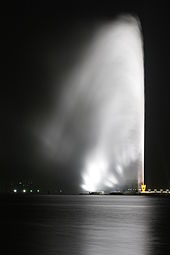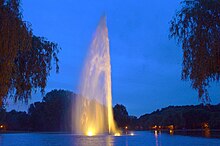fountain




A fountain is a fountain in which water is naturally or artificially pushed up in one or more fountains and is normally collected and recirculated in a basin. In cities, fountains can often be found in public parks or gardens or in representative places as decorative elements or attractions . Fountains with water features can also include cascades , various shaped watercourses, or mechanisms powered by the water.
definition
A fundamental distinction is made between natural and artificial fountains. Fountains in which the water does not have to be carried up are natural fountains. These are located in places where the groundwater is under pressure because the groundwater level is higher than the ground and therefore has a high hydraulic potential. A hole is made there through which the water can escape naturally. This is called the Artesian spring . The artesian well, which can be seen as a jet of water emerging from the ground, was first used in 1126 in Artois. The wells just explained are considered to be deep wells. The simplest fountain, however, is a simple catch basin that catches water from a spring before it can become a stream.
Artificial fountains usually consist of fountains, cascades, spray nozzles and waterfalls.
history
Antiquity
Even in antiquity there were fountains, mostly made of sculptures with occasional water outlets.
Ancient civilizations built stone pools to receive and use precious drinking water. A carved stone basin, from around 2000 BC BC, was discovered in the ruins of the ancient Sumerian city of Lagash in what is now Iraq . The ancient Assyrians constructed a series of basins in the gorge of the Comel River, carved into solid rock, connected by small canals, descending in a stream. The lowest basin was decorated with carved reliefs of two lions.
The ancient Egyptians had ingenious systems for lifting water from the Nile for drinking and irrigation, but without a higher water source it was not possible to make a flow of water that overcame gravity, and no Egyptian fountains or images of fountains have ever been found .
The ancient Greeks appear to have been the first to use aqueducts , gravity-powered fountains, to distribute water. According to ancient historians, fountains existed as early as the 6th century BC in Athens , Corinth and other ancient Greek cities, as endpoints for aqueducts that brought water from springs and rivers into the cities. In the 6th century BC, the Athenian ruler Peisistratos built the main fountains of Athens, the Enneacrounos , in the agora or in the main square of the city. It had nine large cannons, or foothills, that supplied the residents with drinking water.
Greek fountains were made of stone or marble, with water flowing through bronze pipes gushing up from the mouth of a carved mask depicting the head of a lion or the muzzle of an animal. Most Greek fountains were operated by simple laws of gravity, but it was also discovered how the principle of a siphon can be used to make the water run out, as shown by illustrations on Greek vases.
Gothic
In the Gothic period, the vertical was of great importance in architecture. Fountains use an ascending dynamic, comparable to pyramids. They often consist of several shells that form cascades. Gothic elements such as pegs , crabs and finials were used.
Renaissance
In the Renaissance, straight columns were used instead of the Gothic pyramid, the capital of which usually serves as the base of a statue. These statues are figures from ancient mythology or animals such as the heraldic lion, bears, eagles and dolphins. The lower shaft of the column is often surrounded by figures. The edges of the pool and the pillars are decorated with ornaments, as in the Mainzer Marktbrunnen ( Peter Flötner ) from 1526. In Italy, the water was typically directed over steps so that cascades were created. At the end of this era the fountains became wider and the edges were more often decorated with figures.
Baroque
In the Baroque era, the fountains with cascades and large fountains showed the force and mass of the water. The water should combine with the architecture. In the baroque era, the garden water arts were created, such as ponds with artificial grottos and water organs. At Versailles, the king demanded that all water features run at the same time. Since this was impossible due to the shortage of water, the water was pumped from the Seine and only directed to the appropriate fountain where the king was.
Rococo
Compared to the Baroque, more emphasis was placed on details in the Rococo and elegant figures and systems were created. Primarily goddesses were depicted with flower hats and decorations, the stone figures of the fountains were often also in motion. The water flows from flutes, organs and mouths and meets other figures.
In classicism and industrialization, the development of powerful pumps was essential. Now the shape of the water was used more and more, water pictures were created, while sculptures, ornaments and decorations tended to disappear.
Current examples
Even today, large fountains are prestige objects and tourist attractions. After cities had already built fountains as a sign of their status and prosperity in the 19th century, such as the Jet d'eau in Geneva, there is a real competition for beautiful and original water features , but also for the highest possible fountains. The list below shows fountains with the highest fountains without claiming to be exhaustive.
- King Fahd's Fountain , Jeddah , Red Sea - 312 m - salt water, in operation since 1985
- World Cup fountain , Seoul , Hangang - 202 m - fresh water
- Gateway Geyser , St. Louis , Missouri - 192 m
- Port Fountain , Karachi , Arabian Sea - 189 m
- The Fountain, Fountain Hills , Arizona - 91 or 170 m (with 2 or 3 pumps) built by Robert P. McCulloch in 1970 and the world's highest for more than 10 years, city is named after the fountain
- Captain Cook Memorial Waterjet , Canberra , Lake Burley Griffin - 147 m
- Jet d'eau , Geneva , Lake Geneva - 140 m
- Historic Richterswil fountain , Lake Zurich - formerly approx. 80 m, since 2007: 101 m (the world's highest gravity-powered) - 1875 to 1972 and from December 2007
- Emperor Fountain in the garden of Chatsworth House - 84 m
- Large fountain in the Great Garden , Hanover-Herrenhausen - 80 m
- Halle fountain on the Ziegelwiese in Halle / Saale - 80 m
- Inner Alster - fountain , Hamburg - 60 m
- Fountain in Forggensee , Füssen - 60 m (possibly dismantled)
- Degassing-Project-Fountain Nyos-See , Cameroon - up to 50 m (CO 2 emission)
- Lake fountain Friedrichshafen , Lake Constance
- Fountain in the Traunsee near Gmunden
- Lake fountain Lugano - Paradiso
- Obersee -fountain- Arosa
Known fountains:
- Hochstrahlbrunnen at Schwarzenbergplatz, Vienna - 25 m
Private investments
Garden ponds are also often designed as a fountain or provided with a fountain. Among other things, this serves to maintain or improve the water quality through oxygen uptake. There are also small versions for use in the house as a humidifier.
safety instructions
In the vicinity of water basins, including fountains, there is a higher risk of being endangered by electrical systems and equipment due to the damp conditions than in normal dry surroundings. Therefore, special requirements apply to the electrical systems installed in these areas. They are the subject of the standard / safety regulation DIN VDE 0100-702 (VDE 0100-702).
See also
- Heron's fountain
- Fire-fighting ship - temporarily executing inclined fountains
literature
- Naomi Miller: Paradise regained: Medieval garden fountains. In: Elisabeth Blair MacDougall (Ed.): Medieval gardens. Washington 1986 (= Dumbarton Oaks Colloquium on the history of landscape architecture , 9), pp. 135–153.
Web links
Individual evidence
- ↑ fountain . In: Encyclopædia Britannica . Retrieved March 18, 2010.
- ^ Herodotus, The Histories , 1.59
- ↑ Louis Plantier, Fontaines de Provence et du Côte d'Azur , Édisud, Aix-en-Provence, 2007
- ↑ http://www.fontaene.ch/
- ↑ Werner Hörmann, Heinz Nienhaus, Bernd Schröder: Setting up low-voltage systems in damp or wet environments as well as outdoors, in areas of swimming pools, fountains or water basins . VDE publication series Volume 67B, VDE-Verlag , Berlin, ISBN 978-3-8007-2772-8

